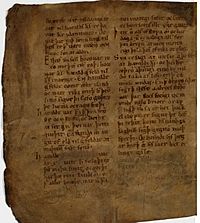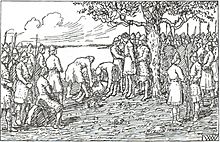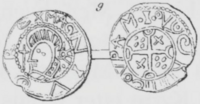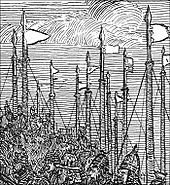Magnus Barefoot facts for kids
Quick facts for kids Magnus Barefoot |
|||||
|---|---|---|---|---|---|
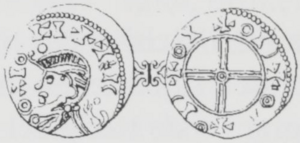
Drawing of a coin from the reign of Magnus Barefoot (with confused legend)
|
|||||
| King of Norway | |||||
| Reign | September 1093 – 24 August 1103 | ||||
| Predecessor | Olaf III | ||||
| Successor | Sigurd I, Eystein I and Olaf Magnusson | ||||
| Co-ruler | Haakon Magnusson (until 1095) | ||||
| King of Dublin | |||||
| Reign | 1102–1103 | ||||
| Predecessor | Domnall Gerrlámhach | ||||
| Successor | Domnall Gerrlámhach | ||||
| Born | 1073 Norway |
||||
| Died | 24 August 1103 (aged 29–30) near River Quoile, Downpatrick, Ulster, Ireland |
||||
| Burial | near St. Patrick's Church, Downpatrick | ||||
| Consort | Margaret Fredkulla | ||||
| Issue more... |
|
||||
|
|||||
| House | Hardrada | ||||
| Father | Olaf III of Norway | ||||
| Mother | Tora?; disputed | ||||
| Religion | Roman Catholicism | ||||
Magnus III Olafsson (born in 1073, died August 24, 1103), often called Magnus Barefoot, was the King of Norway from 1093 until his death. He was known for his many military trips and conquests. He especially focused on the parts of the British Isles where Vikings had settled. He took control of the Kingdom of the Isles and Dublin.
Magnus was the only son of King Olaf Kyrre, who was known as "the Peaceful." After his father died in 1093, Magnus was quickly made king in southeastern Norway. At first, his cousin, Haakon Magnusson, also claimed to be king. They ruled together for a short time until Haakon died in 1095. Some nobles didn't want Magnus as king after Haakon's death, but this rebellion didn't last long.
Once Magnus was firmly in charge in Norway, he started military trips around the Irish Sea from 1098 to 1099. He raided places like Orkney, the Hebrides, and the Isle of Man. He made sure Norway controlled these islands by making a deal with the Scottish king. Magnus used the Isle of Man as his main base and built forts there. He also sailed to Wales and took control of Anglesey after fighting off Norman forces.
After returning to Norway, Magnus led trips into Sweden. He claimed that an old border meant Norway should own more land there. After some battles, the Danish king helped make peace between Norway, Sweden, and Denmark. Magnus made peace with Sweden in 1101 by marrying Margaret Fredkulla, the daughter of the Swedish king. As part of her dowry, Magnus gained the land he wanted.
His last trip to the west was in 1102. He might have wanted to conquer all of Ireland. Magnus made a deal with the Irish king Muirchertach Ua Briain, who agreed that Magnus could control Dublin. But in 1103, while getting food for his trip home, Magnus was killed in a surprise attack by the Ulaid people. His death ended Norway's expansion into these lands.
Even today, Magnus is remembered more in Ireland and Scotland than in Norway. During his rule, Norway became more organized and its church became more like those in other European countries. Magnus is often seen as a Viking warrior, not just a medieval king. He was the last Norwegian king to die in battle in another country. Some even call him the last true Viking king.
Contents
How We Know About Magnus
Most of what we know about Magnus comes from old Norse stories called sagas. These stories started being written down in the 1100s. The most important ones we still have are Historia de Antiquitate Regum Norwagiensium and Ágrip af Nóregskonungasögum. Later, longer sagas like Heimskringla (by Snorri Sturluson) and Morkinskinna were written around the 1220s. These later stories have more details, but they might not be as accurate. We also find information about Magnus, especially his battles, in writings from the British Isles.
Magnus was born around 1073. He was the only son of King Olaf Kyrre. We are not completely sure who his mother was. Different old stories name different women. Most historians today think his mother was Tora Arnesdatter.
Magnus grew up in Nidaros (which is now Trondheim), the main city in Norway at that time. His father's cousin, Tore Ingeridsson, helped raise him. When he was young, Magnus seemed more like his strong, warlike grandfather, King Harald Hardrada, than his peaceful father. People said Magnus was handsome and smart. Even though he was shorter than his grandfather, he was known as "Magnus the Tall."
His most famous nickname, "Barefoot" or "Barelegs," came from his choice of clothes. He started wearing the short tunics of the Irish and Scots, which left his lower legs bare. Another story says he got the name because he had to run away from a Swedish attack without his shoes. Because he was so aggressive and fought many wars, he was also called styrjaldar-Magnús, which means "Warrior Magnus."
Magnus' Time as King
Becoming the King of Norway
Norway had been peaceful for a long time under Magnus' father, Olaf. Magnus was likely there when Olaf died in September 1093. He was probably made king soon after. When Magnus became king, he already had strong support from important nobles in Norway.
Magnus quickly focused on the lands to the west, towards the British Isles. These areas were in chaos after a powerful Viking leader died. This gave Magnus a chance to get involved. Some stories say he went on his first trip west in 1093–94. He might have helped the Scottish king take over Edinburgh. In return, he might have gained control of the Southern Isles. But it's not clear if this early trip really happened.
Magnus faced a challenge from his cousin, Haakon Magnusson. Haakon was the son of King Olaf's brother and claimed half of the kingdom. Haakon was also made king in other parts of Norway. Haakon gained support by lowering taxes for farmers. Magnus, however, had expensive plans and asked for long military service. Their relationship became tense. Haakon died unexpectedly in February 1095 while hunting.
After Haakon's death, some powerful nobles refused to accept Magnus as king. They tried to set up another person as king. This rebellion started in the Uplands but spread. After a few weeks of fighting, Magnus captured the leaders of the revolt. He had them hanged. Magnus was reportedly upset that he couldn't pardon one young, promising nobleman named Egil. But as king, he could only pardon him if other nobles asked, and they didn't.
Magnus had one last problem at home with a noble named Sveinke Steinarsson. Sveinke refused to accept Magnus as king. Sveinke was good at stopping pirates, but he was forced to leave Norway for three years. When piracy increased after he left, Magnus asked him to come back. They made up, and Sveinke became a loyal supporter. Magnus was now the undisputed king of Norway.
Changes in Norway
Old Norse stories mostly talk about wars, so we don't know as much about other things that happened during the reigns of early Norwegian kings. For example, Snorri Sturluson wrote much more about Magnus than about his peaceful father, Olaf. This means our view of kings like Magnus might be mostly about their warrior side.
During Magnus' rule, Norway became more like other kingdoms in Europe. The king's power became stronger. He worked with a group of powerful nobles, some of whom were his relatives. The church organization also grew. Even though Nordic bishops were part of a larger church area, Magnus really controlled the church in Norway.
We also know that Magnus changed the way coins were made. He made sure coins had more silver in them again, about 90 percent. This was a big improvement from earlier coins that had much less silver.
First Trip to the Irish Sea
Magnus wanted to bring back Norway's power around the Irish Sea. In 1097, he tried to put a new king in charge of the Southern Isles, but that king was killed. It's not totally clear what Magnus' main goal was. Some historians think he wanted to create a large empire that included Scotland and Ireland. But most Norwegian and Scottish historians believe he mainly wanted to control the Viking communities around the Irish Sea.
In 1098, Magnus sailed into the Western Sea with a large fleet of ships. When he arrived in Orkney, he sent the local earls (leaders) to Norway as prisoners. He took their sons as hostages and put his own young son, Sigurd, in charge of Orkney.
Magnus then raided Scotland, the Southern Isles, and Lewis. He didn't face much resistance. He continued to raid other islands like Uist, Skye, Tiree, Mull, and Islay. He visited Iona but didn't raid it. When he entered the Irish Sea, he lost some ships and men in Ulster.
Magnus then went to the Isle of Man. He won a big battle there and took control of the island. Magnus and his men stayed on the Isle of Man for a while. He encouraged Norwegians to move there and built or rebuilt several forts and houses. He used wood from Galloway in Scotland, which suggests he also controlled parts of that area.
Magnus might have planned to invade Ireland next, but he may have realized he had gone too far. He was then asked for help by Gruffudd ap Cynan, the King of Gwynedd in Wales. Gruffudd had been forced out by Norman lords. Magnus sailed to Anglesey in Wales. He arrived just as the Normans were celebrating a victory over the Welsh. In the battle that followed, known as the Battle of Anglesey Sound, Magnus killed one of the Norman leaders with an arrow and defeated their forces.
After this battle, Anglesey was seen as the southern border of Norway's influence. Gruffudd ap Cynan soon returned to Anglesey and gave Magnus gifts and honors. This might mean that Gwynedd had accepted Magnus' rule. The English probably started to worry about Magnus' growing power, remembering earlier invasions by his grandfather.

In Scotland, different kings were fighting each other. King Edgar had a small advantage. The stories say that Edgar, fearing a battle with Magnus, offered to give up all Scottish claims to the islands west of Scotland in exchange for peace. Magnus accepted this offer. The deal reportedly gave him every island a ship could reach if its rudder was kept straight. He even showed that Kintyre should be included by sitting at the rudder of his ship as it was dragged across a narrow strip of land. Historians believe a formal agreement was likely made with the Scots. Magnus spent the winter in the Hebrides, making the islands stronger. He returned to Norway in the summer of 1099. However, many of the islands he had conquered, like Anglesey, were only loosely under Norwegian control.
Fighting in Sweden
After returning to Norway, Magnus looked east. He claimed an old border meant that the Swedish areas of Dalsland and Västergötland should belong to Norway. He believed the border should be further east, along the Göta älv river and through Lake Vänern. Swedish king Inge Stenkilsson disagreed. Magnus started a campaign, raiding villages.
Magnus built a wooden fort on an island in Lake Vänern. He left 300 men there for the winter. The Norwegians there seemed very confident and even made fun of the Swedish king for taking so long to arrive. When the lake froze, Inge arrived with about 3,000 men. He offered to let the Norwegians go home peacefully, but they refused. The Swedes then attacked and burned the fort. The Norwegians were allowed to go home, but they lost all their belongings.
Magnus was angry about this defeat and planned revenge. He went into Sweden again the next year, taking back the same areas. But during this quick trip, Magnus and his men were ambushed by Swedish forces. They had to run back to their ships, losing many men. The war continued until 1100 or 1101.

The Danish king, Eric Evergood, was worried the fighting would get worse. He started peace talks between the kings. The three Scandinavian kings finally agreed to meet near the border. They decided to keep the old borders. Magnus married Inge's daughter, Margaret Fredkulla, who was called "Colleen-of-Peace." Through this marriage, Magnus gained the lands he had claimed. Since they had no children, Dalsland went back to Sweden after Magnus died.
Last Trip to the Irish Sea and Death
Magnus went to Ireland again in 1101 or 1102, probably with an even bigger army. One of his biggest challenges was dealing with the many small kings and alliances on the island. Irish stories say Magnus came to "take Ireland." He got more soldiers from Orkney on his way to the Isle of Man, where he set up his base.
Magnus made a peace agreement with Muirchertach Ua Briain, the king of Munster in Ireland. As part of this deal, Magnus' son, Sigurd, married Muirchertach's daughter. On their wedding day, Magnus made Sigurd his co-king and put him in charge of the western lands. Muirchertach also agreed that Magnus could control Dublin.
Magnus and Muirchertach went on raiding trips together after their peace agreement. They only stopped for the winter. The stories say Magnus spent the winter in Connacht, but historians now think he stayed closer to Dublin. Magnus was probably helping Muirchertach in his fights against a rival king.
On August 24, 1103, Magnus and his men went into the country to get food supplies for their trip back to Norway. It's possible they were just raiding for cattle, or the local people, the Ulaid, thought they were raiders. Another idea is that Muirchertach might have told the Ulaid to bring food to Magnus, but secretly told them to attack instead.
Norse stories say a large force of Irish fighters suddenly appeared from hiding. The Norwegians were surprised and not ready for battle. Magnus tried to get his army in order. He was hit by a spear through both thighs but kept fighting. An Irishman with an axe then struck a deadly blow to his neck. Magnus was the last Norwegian king to die in battle in another country.
Some think Magnus was betrayed by Muirchertach, or even by some of his own men who fled during the battle. Magnus' son Sigurd returned to Norway without his child bride after his father's death. Norway's direct control in the region ended. Even though Norwegian influence remained, no Norwegian king returned to these lands for over 150 years.
Magnus' Children
Magnus married Margaret Fredkulla, the Swedish king's daughter, as part of a peace deal. They did not have any children together. His three sons, who became kings after him, were born to different mothers. He also had two known daughters:
- Eystein: Born in 1089. His mother was "of low birth."
- Sigurd: Born in 1090. His mother's name was Tora.
- Olaf: Born around 1099. His mother was Sigrid Saxesdatter.
- Ragnild: She married Harald Kesja, a Danish prince.
- Tora: She married an Icelandic chieftain.
Years after Magnus died, other men claimed to be his sons. We can't be sure if these claims were true:
- Harald Gille: Born in 1103 in Ireland. Magnus' son Sigurd accepted him as his brother.
- Sigurd Slembe: His mother was Tora Saxesdatter. Harald Gille did not accept his claim.
What Happened After Magnus' Death
Where Magnus Was Buried
Magnus likely died near the River Quoile in Ireland. Stories say he was "buried near the Church of St Patrick, in Down." There is a mound about two miles south of the cathedral that became known as Magnus' Grave. The description of the marshy land where Magnus was attacked fits the area around this mound. This makes it a likely spot for his burial. A stone monument was put up there in 2003 to mark 900 years since his death.
Who Ruled Next
Magnus was peacefully followed by his three sons: Sigurd, Eystein, and Olaf. Sigurd outlived his brothers. In the late 1120s, a man named Harald Gille came to Norway from the west. He claimed to be Magnus Barefoot's son and the rightful heir to the kingdom. Sigurd accepted Harald as his brother after Harald passed a special test. Harald was made king after Sigurd died in 1130, along with Sigurd's son Magnus Sigurdsson.
Later, Harald was killed by another man who also claimed to be Magnus Barefoot's son, Sigurd Slembe. Sigurd Slembe was not accepted as king. This started what became a century-long period of civil wars in Norway.
Magnus' Lasting Impact
Magnus' name became popular in Ireland in the 1100s. Stories say that Norway still received payments from Ireland for about twelve years after Magnus died.
Magnus became a character in at least two old Irish songs called Gaelic ballads. In one version, he returns to Norway after his trip. In another, he is killed. These different versions probably come from his two trips to the west. There are also stories about Magnus in Scotland, in legends and local history.
Today, a "Magnus Barelegs festival" is held near Downpatrick in Ireland every two years. In Norway, however, Magnus is not as widely remembered. When King Magnus was killed, his sword, named Legbiter, was brought back to Norway.


